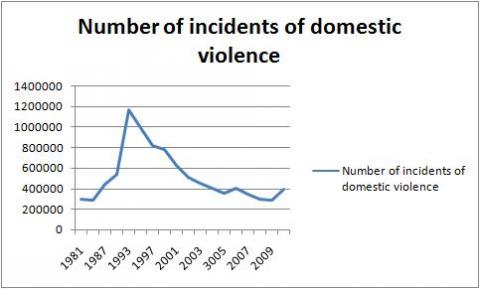How many people were victims of domestic violence over the last year?
"Domestic violence has fallen from a peak of more than one million incidents in 1993 to just under 400,000 last year, the crime survey said."
The Times, 19 July 2012
"The latest statistics from the British Crime Survey show that every year in the UK more than 1 million women suffer domestic abuse."
The Guardian, 22 July 2012
"We are concerned that the British Crime Survey tells us that there are an estimated 1.2 million women who experience domestic abuse each year in the UK."
Sandra Horley, Chief Executive of Refuge, for the BBC, 23 July 2012
Data measuring domestic violence has yet to be fully touched upon by Full Fact and, with a clash of statistics being witnessed in the press recently, it seems time to clear up any resulting confusion.
In one corner, we have the Times, claiming that under 400,000 people were victims of domestic violence last year, and in the other corner, the Guardian and Sandra Horley of Refuge report that there were more than double the number of cases for females alone last year. How can they both be right?
Analysis
Taking first the Times article, we are led to the British Crime Survey (BCS) as a source for its statistics on domestic violence. The BCS (since April 2012 known as the Crime Survey for England and Wales) is a large sample survey of victims in England and Wales, carried out by the British Market Research Bureau (BMRB) for the Home Office.
The most recent figures for domestic violence can be found in "Crime in England and Wales 2010/2011", published by the Home Office in July 2011.
The quarterly BCS asks around 50,000 men and women aged 16-59 about crimes they have experienced in the last year. Using the experiences of the respondents for each type of crime, the BCS then estimates the prevalence of each type across the whole of England and Wales.
For domestic violence, the BCS estimated that there were 392,000 incidents of domestic violence across England and Wales in 2010 to 2011.
This does indeed support The Times's claim, as do the figures in the extended tables of the Survey, which report 1,116,000 incidents of domestic violence in 1993.
To give some context of this change, the graph below depicts the BCS statistics of incidents of domestic violence overtime.

The graph shows how there has been a sharp decline in the estimated number of incidents since 1993, which has recently shallowed out.
But is it a reliable measure?
An advantage of the BCS survey is that it does not rely on police reports, meaning it does not exclude any crimes that never came to the attention of the police, which is particularly important for crimes like domestic violence, which has a notoriously low-reportage level.
However, the "Crime in England and Wales 2010/2011" also highlights the shortcomings in the methodology of this BCS data. The statistics above were gathered by face-to-face BCS interviews, which is a method recognised to be unreliable when used to measure domestic violence, due to a significant degree of unwillingless among respondents to disclose such details personally to an interviewer.
This is why the BCS also captures data on domestic violence via a self-completion module, which allows the respondent to write experiences directly onto the interviewer's laptop.
The Home Office make this clear:
"Domestic violence figures that relate to incidents reported in face-to-face BCS interviews should be treated with caution. Prevalence rates for domestic violence derived from the self-completion module are around five times higher for adults than those obtained from the face-to-face interviews"
Indeed, the results for this self-completion module do show overall rates five times higher - at two million in total:
"Seven per cent of women and five per cent of men reported having experienced domestic abuse in the last year, equivalent to an estimated 1.2 million female victims of domestic abuse and 800,000 male victims."
These are the figures given by Ms Horley and the Guardian.
So when a certain level of anonymity is given to the BCS respondents, a much higher incident rate of domestic abuse is reported.
'Domestic violence' and 'Domestic abuse'
Keen-sighted Full Fact readers will have noted another difference between the reports in the Times and the Guardian/Ms Horley. The phrases used in the articles to depict crimes of this sort are different: the Times uses "domestic violence" and the Guardian and Ms Horley use "domestic abuse".
Does this also account for such a difference in the figures? The Home Office are clear that the two aren't exactly the same. While there are significant overlaps, the self-completion figures additionally include emotional and financial abuse, along with threats to do such. It also adds in experiences of sexual assault (and threats and attempts of such) as well as stalking.

So while there are similarities between the terms, it is certainly understandable that figures for 'abuse' should be higher than figures for 'violence' if other factors are being detected.
It still indicates however that the figures for domestic abuse acquired by the self-completion module of the BCS give us a more useful picture of violence anyway - as well as wider factors of abuse.
Conclusions
The large discrepency between the figures quoted in the Times and the Guardian/Ms Horley can be traced to two factors - the different definitions used and the different methods by which the data was gathered.
The Guardian's higher figure is in part because emotional and non-violent coercive factors are being considered, thanks to the more reliable data collection method obtained by self-completion for this particular type of crime.
However the Times's figure, while only referring to domestic 'violence', may still underestimate even this given the face-to-face nature by which the figures are gathered.